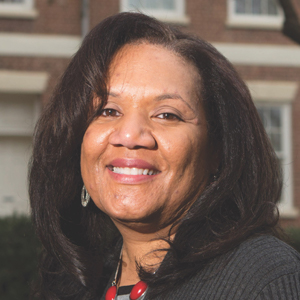Colorblindness as ideology
Like many African-Americans who attended college in the late 1980s and even the early ’90s, I was often the only black student in my lab or seminar. One afternoon, I attended a large class in another department with others in my program cohort and again found myself the lone black student. The junior faculty member teaching the class shared a story from his own graduate school days about the time he mistook his new black major professor for someone not on the faculty. In fact, he said he repeatedly challenged this MP to tell him when the “real” professor would return.
My instructor thought his story was humorous, and it appeared everyone else in the class did too. I did not. His effort to connect with students through this story did not make me feel relaxed. In fact, it did the opposite; I felt put on alert. How could this professor actually see me if he felt at home sharing a story about his own racialized expectations of who faculty are? Not only was I left once again navigating my token experience, but now I had the additional burden of managing my professor’s implicit expectation of what faculty and doctoral students look like. Clearly, I did not fit the mold.

Colorblindness is a popular diversity model or ideology that on the surface reflects pro-diversity intentions but in practice suppresses diversity and elevates sameness. For decades, society has espoused the virtues of colorblindness as a method to avoid discriminating based upon race. In reality, colorblindness may be self-preservation. It allows us to pretend that if we do not see race, then we cannot act based upon race. “I don’t see color” and “We’re all one race, the human race” are common expressions of colorblindness. However, we cannot help but see differences; it’s unavoidable. Pretending that those differences are not there does not eliminate discrimination. Colorblindness erases the plausibility of race as a cause for mistreatment, thus making it more difficult to avoid or resolve racial bias in the future. For people of color, colorblind messages like “We’re all the same” may send a message of cultural insensitivity to their lived experiences as underrepresented minorities, or URMs, especially in fields such as science, technology, engineering and mathematics where there is severe underrepresentation.
As I look at doctoral programs today, it appears little has changed since I was a student. I appreciate white faculty members’ attempts to connect with their students and their efforts to diversify academic disciplines. However, well-meaning behaviors do not always translate into effective diversity practice. Well-funded programs born of good intentions sometimes reflect colorblindness, ultimately signaling an identity threat to people of color that may result in ineffective cross-racial mentoring and weak student retention.
Closing the gap
Despite the time and money invested in programs to recruit, retain and graduate women and URM students in STEM fields, the demographic reality of these professions has not shown a significant payoff. A 2011 U.S. Department of Commerce report shows that the representation of women in STEM has rested at 24 percent since 2000; only 4.8 percent of today’s scientists identify as black or African-American, according to the National Science Foundation. Our studies suggest that underrepresented grad students are largely dissatisfied with their graduate school experience and NIH researchers have found they often do not consider an academic career path attractive. These students’ lack of satisfaction seems to show up in their relatively low levels of confidence for success in STEM academic paths and perhaps even in their reluctance to pursue STEM careers, despite faculty support. This further limits the opportunity for future URM students to encounter role models like themselves in college and graduate school.
Many STEM programs have attempted to close their diversity gap through efforts to expose more URM students to these disciplines earlier in their academic careers. Other efforts have focused on closing academic achievement gaps in critical areas, such as math. Although well-intentioned, both strategies perpetuate a model of URM students as having a lack or deficiency. As an organizational scholar, I feel compelled to ask, What if STEM disciplines sought to identify and remedy their own internal deficiencies that create barriers to participation by URMs?
Research suggests that, regardless of their disciplines, faculty rarely are trained to mentor any student and that, given that faculty mentors of URM students are frequently white and male, they often lack multicultural competence and have not reflected upon or explored the relevance of race (their own and others’) in their daily lives as their URM students do. These faculty are likely to embrace models of diversity that appear inclusive on the surface but derail diversity in their implementation. At this ideological level, STEM education programs may focus on intervening in students’ preparation in order to become more diverse programs rather than understanding the program issues that deter student entry and engagement.
One strategy for closing the diversity gap in STEM may be found in examining faculty and URM students’ interpersonal relationships at both the undergraduate and graduate school levels. These students often find themselves as pioneers and tokens in programs that are desperate for their success. Well-meaning faculty and even peers go out of their way to support racial minority students and colleagues, yet these students still experience marginalization and exclusion. So what goes wrong?
Models of diversity
Diversity science may show how good intentions and well-meaning behaviors derail critical mentor-protégé relationships, especially when URM students have majority-group mentors. Many of these mentors, regardless of their age, have been socialized to embrace and emulate colorblindness. Colorblind models of diversity downplay differences, especially with regard to race, which is already a taboo subject. Sentiments such as “We’re all one race, the human race” illustrate this model.
In contrast, multicultural models seek to make diversity visible in order to facilitate an appreciation of differences rather than a silencing of them. Multicultural ideologies see acknowledgement of students’ diversities as an opportunity for growth and learning. Colorblind ideologies consistently are preferred by majority group members, according to a University of Nebraska study, whereas people of color often prefer multicultural models of diversity.
Colorblindness may signal identity threat to people of color rather than identity safety. One field study of hospital professionals found that, at the department level, white colorblindness was related to decreases in minority worker engagement and the reverse was true for minority workers who worked with more multiculturally oriented whites.
Another experiment suggests that whites’ diversity ideologies have performance consequences for minorities; when URM research participants were paired with white participants, whites’ exposure to the two diversity models mattered. When whites were exposed to a colorblind model before their interaction with a URM partner, URM performance on a cognitive ability task decreased. Furthermore, analysis of the video of their interaction found that whites exposed to colorblindness behaved in more discriminatory ways toward their URM partners. Leaders’ diversity ideologies also appear to have an effect, such that URM members felt accepted in groups led by multicultural leaders but distanced themselves from their peers and experienced relationship conflict when group leaders were colorblind.
Minorities’ expectations that colorblindness may place them at risk for bias or discrimination appear to be supported by research in and outside of education. One organizational field study demonstrated that when an organization’s rhetoric reinforced colorblindness, minority workers had low expectations of organizational diversity, expected heightened risk for bias and lowered expectations of their own performance; for black women in particular, this led to decreased performance. Individuals high in colorblindness appear less able to detect signs of bias such as microaggressions, those chronic ambiguous slights that often reinforce URM students’ marginality and stereotypes. One example is when faculty comment to URM students, “Actually, that’s a good idea …” The use of “actually” suggests that good ideas are not expected from that URM student, especially when the same type of feedback is not provided to majority-group students when their ideas are good. Majority students simply are expected to have good ideas.
Research on STEM education in K–12 settings suggests that colorblindness may be a predictor of faculty interactions and effectiveness with diverse students. A 2015 study by German researchers found that colorblind teachers were less willing to adapt their instruction to culturally diverse students. Perhaps most alarming are the findings of a case study suggesting that colorblind STEM teachers interact with URM students from a deficiency perspective that positions the students as inherently inferior, less prepared and less interested in STEM rather than attending to how the history of exclusion in education and inhospitable climates for learning may disadvantage URM students. I agree with the authors, who fear that the framework from which these colorblind teachers interact with their URM students may derail these students’ STEM-related confidence, interest and career aspirations.
Looking forward
STEM organizations should continue to pursue their past access and education strategies but also take ownership of their diversity ideologies and the negative, identity-threatening messages they might be sending, however well-intended. Our science communities must assess their readiness for diversity and be willing to invest in efforts to educate the STEM community about how issues like race, identity and culture interact with access, development, training and perseverance in the sciences.
Professional development for faculty and graduate students (future faculty) should include attention to mentoring, particularly in diverse dyads. Trust and relationship building within a same-race pair is likely a different process compared with the relationship between a mentor and student from different backgrounds. A focus on the importance of a multicultural and inclusive framework is necessary to reduce the risk of sending colorblind messages to the very students we hope to develop into the next generation of scientists. Challenging common sayings like “You have to be chained to the bench” or “You have to be a slave to the bench” may be a first step.
The science community also should consider the variety of career paths that underrepresented students might desire relative to their white peers and accept that not everyone desires a publish-or-perish tenure-track position at a research-intensive institution. Likewise, we must acknowledge that these other career paths have value for minority communities, for STEM and for society as well.
In my experience coaching a small group of black postdocs, I learned that their reasons for earning a Ph.D. in STEM differ vastly from the motivations I usually hear from my STEM colleagues. These young black Ph.Ds. say they are primarily driven by their desire to be of value and to be visible role models in their community. This conflicts with the images of young scientists sleeping in their labs and occasionally looking out at an ivory tower in the distance. For my black postdocs, the STEM subject matter of their research is a vehicle to elevate the aspirations of their community’s youth and to prove to them that black kids have a vast array of opportunities available to them. Their research is important to them, but for many it is not their sole or primary motivator.
Becoming more-inclusive scientists and STEM professionals requires that we acknowledge and appreciate the diversity of our students. We must take to heart their motivations and the feedback they provide to us in person or through climate assessments and exit surveys that will allow us to support them more effectively.
Enjoy reading ASBMB Today?
Become a member to receive the print edition monthly and the digital edition weekly.
Learn moreGet the latest from ASBMB Today
Enter your email address, and we’ll send you a weekly email with recent articles, interviews and more.
Latest in Opinions
Opinions highlights or most popular articles

A paleolithic peer review
You might think review panels have only been around for the last century or so. You would be mistaken.

Early COVID-19 research is riddled with poor methods and low-quality results
The pandemic worsened, but didn’t create, this problem for science.

So, you went to a conference. Now what?
Once you return to normal lab life, how can you make use of everything you learned?

My guitar companion
A scientist takes a musical journey through time and around the world.

Catalyzing change and redefining purpose
To mark Women’s History Month, Sudha Sharma writes about her journey from focusing on her own research program to being part of a collaborative COVID-19 project.

The power of sabbaticals
To mark Women’s History Month, Nicholas Rhind writes about learning techniques in other researchers’ labs that empower the work in his own.

